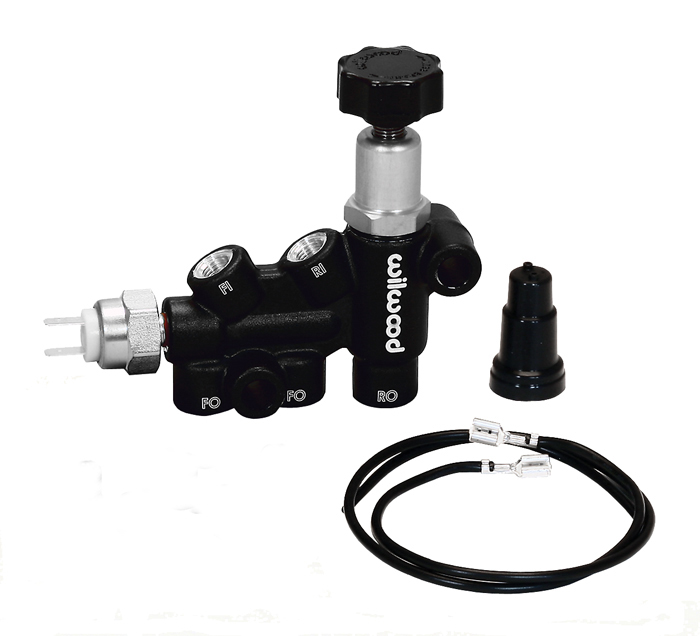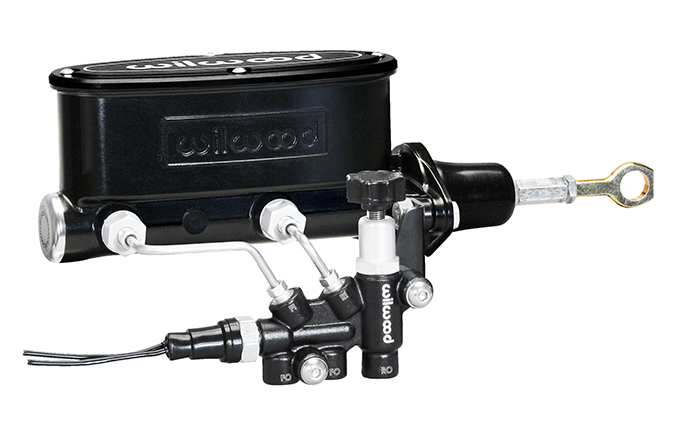
I've just put a new Wilwood master and prop valve on my car, and I'm having a hell of a time getting the system to bleed.
I've managed to bench bleed the master (several times, on and off the car). When it's bled with no brake lines attached, I get a pedal. All good there.
When I connect it to the proportioning valve (260-11179, the 2-inlet, 3-outlet model, picture below), I can bleed the rear brakes, but the fronts are full of air. After the bleeding attempt, the master is full of air again as well. As a sanity check, I removed the pressure switch on the front of the prop valve to find... nothing. The valve is full of air. No fluid is entering the prop valve from the master.
Now, I have fluid at the connection from the master to the prop valve front port, but the fluid simply is not getting into the prop valve, which leads one to think the inlet port is simply blocked. But! When trying to bleed a front caliper, if you open the bleeder with the pedal down, and allow the pedal to come back up with the caliper bleed open, you can hear air being sucked into the caliper.
So it's like there's a check valve in the prop valve inlet that's been fitted backwards. It's blocking fluid flow out of master, but allowing air to revert back in.
Does anybody know what the inside of this thing looks like? Are there check valvesd in the prop valve body? Would it be possible they got installed backwards?
I'm going to remove the valve tomorrow and plumb the brakes directly to the master to be sure. Wilwood said they'd replace the prop valve if I do that and it starts working, but I'd really like to know what is really happening here. I hate changing parts without a good reason.
Thanks!
Andrew

ascott wrote:
When trying to bleed a front caliper, if you open the bleeder with the pedal down, and allow the pedal to come back up with the caliper bleed open, you can hear air being sucked into the caliper.
The solution is to either close the bleed screw before releasing the pedal, or attach a hose to the bleed screw and have the end in a jar of brake fluid. I don't think there's anything wrong with the parts.
So I'm supposed to suck fluid up into the prop valve from the caliper? Not push it down out of the master?
What I was describing was a troubleshooting experiment, not my normal bleeding procedure. When bleeding, I have a hose with a check valve in it attached to the bleeder, with the opposite end immersed in fluid. I'm getting nothing out of the front calipers. The rears bleed fine. taking the check valve off results in... still nothing. I'm not getting any bubbles in the fluid in the jar.
I cracked the passenger caliper bleeder last night and just let it sit open overnight. It should have gravity bled all over the floor, but nothing!
Ah, I understand better what the problem is. Interesting, I'd be tempted to poke a compressed air nozzle in that FI port and see if anything comes out FO. I've never dealt with this particular prop valve from Wilwood, so I don't have any insight into what's going on inside.
Did you change the master as well, or is this valve going into plumbing that was already working fine?
It's a new master and plumbing from the master/prop assembly down to the old factory prop valve location (this is a 1987 Buick GN), where I've tied into the existing (working) lines with unions.
Any chance you got front and rear mixed up at the master? I've seen weird stuff happen because of that. It shouldn't make any difference, but it can.
Sadly, no. This prop came with the master in a kit, there's no way to get it wrong:

The instructions are also very specific that the front reservoir and port are for the brake set with the largest piston diameter. So that's how I hooked it up.
I grabbed a few more pre-flared lines on the way home from work (my Harbor Freight flaring tool didn't cut the mustard, highly NOT recommended) and will be able to bypass it completely in the morning. We shall see...
I emailed Wilwood earlier asking about if there was a check valve in the inlet. No response as of late. I did call them yesterday (but hadn't thought of the possibility of a check valve issue, or I would have asked then) and they said if I bypassed it and the lines bled, they'd trade the valve out for a new one, so there's that.
I was just hoping somebody on here had dealt with one and would have a handy tip like "hit it with a hammer".
Ok, I got it. After getting some help from an extra set of eyes, we seem to have closed off all the leaks and the system bled.
The pedal is still spongy and it stops like crap, so I wasn't able to get all the air out. I'm going to get it pressure bled Tuesday and we'll go from there.
So what was it, a leak?
I've found that pressure bleeders can slightly aerate the fluid. Gravity bleeding is my favorite way to get a solid pedal.
It was a bunch of things. Just about all the unions in the system were leaking, some I had to tighten two or three times. I'd find it wet, crank down on it some more, it would sit and not leak, then would weep again when I started stomping on the pedal. There was air in the master, so I had to bench bleed it again.
But the thing that really fixed it was getting the drums properly adjusted. The shoes had backed WAY off the drums, so I was wasting most of the pedal push just getting them pushed back out.
I am happy to report that the brakes performed flawlessly in my region's inaugural autocross this past Sunday. Thanks for the eyeballs!
Glad that it all worked out. I have a good bit of experience dealing with difficult to bleed brake systems in odd ball industrial vehicles. I find that when they give me trouble, its best to reverse bleed, that is, push the fluid up to the master from the wheel cyl, slave cyl or caliper. Works every time
FWIW, I had a double flare tool from HF, it was awful and I promptly returned it. I picked up an equivalent tool from Sears, it was much, much better and still relatively cheap.





























